Jumping oak gall causing damage to white oak
Oak leaf galls are normally harmless, but the jumping oak can defoliate a severely affected tree.
Jumping oak galls are tiny, seed-like galls that form on the undersides of white oak leaves. They are caused by the tiny gall wasp, Neuroterus, at or near saltatorius (Hymenoptera: Cynipidae). The galls cause the upper surface of the leaf to lighten in color and form a kind of blister that is often ringed with a yellow halo. Severe infestations will cause the leaf tips to turn brown. Heavily damaged leaves may curl and fall from the tree and the entire crown of the tree may be affected.
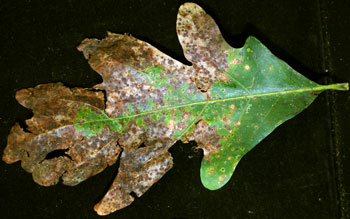
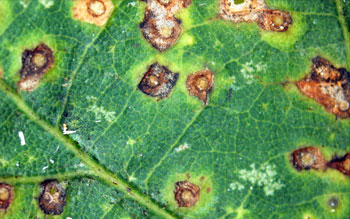
Left, Jumping oak gall damage to an oak leaf. Right, The upper surface of the leaf showing the yellow halo. Photo credits: Jackie Smith, MSU Diagnostic Services
Each gall contains a single wasp larva that feeds on the inner lining of the gall. The galls drop to the ground when they have matured. The activity of the larva inside the gall actually makes the gall jump around on the ground after they have fallen from the tree. The insect overwinters inside the gall. In the spring, the females emerge and lay their eggs in newly opened leaf buds. The galls form in response to chemicals in the larva’s saliva.

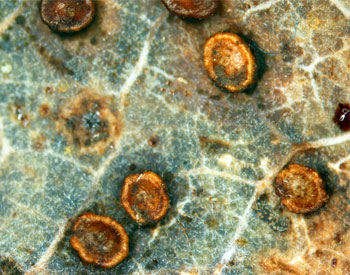
Left, A gall wasp pupa that was removed from a gall. Right, A close up of jumping oak galls on the underside of the leaf. Photo credits: Jackie Smith, MSU Diagnostic Services
Gall makers must attack the plant at a very precise time if normal plant tissue is to be successfully stimulated to form a gall. It has been shown that trees whose buds open earlier than nearby trees have larger numbers of these galls than trees whose buds opened later. Oak leaf galls do not seriously injure the tree and control with insecticides is not recommended.
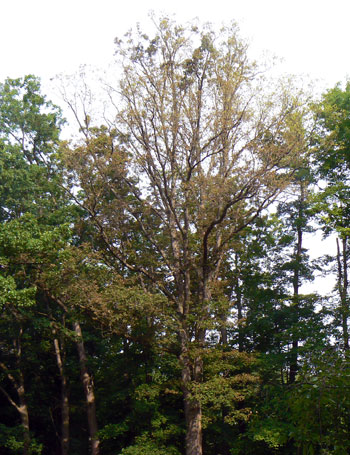
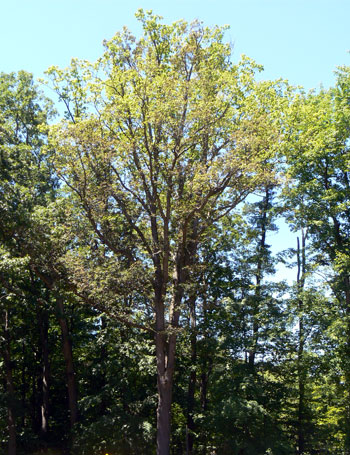
Left, A white oak that was nearly defoliated as a result of a severe infestation of jumping oak gall. Right, This is the same tree a week or so later showing new leaves growing. Photo credits: Dave Filipiak
More on oak gall makers
Wherever oak trees grow, they are hosts to a group of tiny insects called gall makers. These insects cause abnormal growths or deformities, known as galls, of all manner of sizes, shapes and colors on leaves, twigs, bark, buds, flowers, acorns and even roots of the tree. The oak apple galls are just one of several hundred types of galls that form on oaks in the eastern United States. The galls are far better known than the insects that cause them.
Most of the oak gall makers are tiny wasps in the Cynipidae family, but there are a few in which flies are responsible. Galls are caused by powerful chemicals or stimuli produced by the insect that interact with the tree hormones to produce the gall. The inner wall of the gall is rich in protein and other nutrients, which provides the developing larvae inside the gall with concentrated food supply. The galls also serve to protect the larvae, but not completely, from parasites and predators.
Each gall-maker induces the growth of its own distinctive gall that is unlike the galls formed by other species. Galls are so common on oaks that many people regard them as typical structures of the tree. Many gall makers have complicated lifecycles with a phenomenon known as heterogamy or alternation of generations. The offspring of these gall makers produce galls that are quite different than their parents, but that are identical to the galls produced by their grandparents. The alternating generations often produce galls on different parts of the oak tree. And, more amazingly, the alternating generations of wasps often differ in body structure to the extent that they appear to be two different species.
Oak leaf galls do not cause serious injury to the tree and Michigan State University Extension does not recommend attempting to control leaf gall makers with insecticides. Oak trees and gall makers have been getting along together for thousands of years. Insecticides should only be employed when the health of the tree is threatened.



 Print
Print Email
Email

